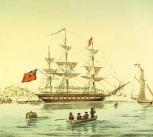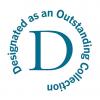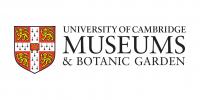What’s in the collection?
Around 470 birds from eastern and north-eastern Australia, New Guinea and the islands of the Great Barrier Reef and Torres Strait, plus four marsupials (two greater bilbies and two brushtail possums).

When did it arrive?
1846
What do we know about the specimens in Cambridge?

They were collected during the voyage of the HMS Fly between 1842 and 1845, on which Blackwood was the commanding officer. This was the British Admiralty’s first hydrographic survey for exploring and charting the north-east Australian coast. Aboard were the geologist Joseph Jukes and the zoologist John MacGillivray (whose resulting collections were presented to the British Museum (Natural History)). The companion ship was the HMS Bramble, for which Bramble Cay was named (it already had the name Maizab Kaur) – Bramble Cay is the site of the first confirmed mammal extinction caused by anthropogenic climate change, the Bramble Cay melomys.
Under Blackwood’s direction, the survey made significant advances in mapping the Great Barrier Reef, the islands of the Torres Strait and New Guinea, as well as the north-eastern Australian coast. The Fly River in New Guinea is named after the ship.
Blackwood initially proposed selling the collection to the Museum (for £300, although it was said to be worth £500) to cover financial concerns that resulted from a drop in his income, however he decided to make it a donation on account of “all the attention and civility he had met with in Cambridge while preparing for his voyage, this hearty acknowledgements for the information on scientific subjects so freely given to him – particularly his obligation to Prof. Challis”.(Ref. 1)
A report on the collection at the time stated: “They are in pairs male and female; are in perfect condition and most beautiful plumage, and are above 300 in number, including nearly all the known birds of Australia, some from the imperfectly explored coasts of New Guinea, some beautiful specimens of Malacca Pheasants, etc.” (Ref. 1)
The inclusion of a male and female greater bilby in this collection is potentially interesting, as their reported historic distribution does not extend east of the Great Dividing Range or to the north coast. It is therefore unclear where Blackwood obtained these specimens (assuming they do not represent a range extension). The only time the Fly appears to have stopped near bilby territory is ten days spent at Swan River (Perth) on its journey home.
Who was Francis Blackwood?
Francis Price Blackwood was a distinguished naval captain who surveyed – among other places – the waters of northern and north-eastern Australia, and the Torres Strait as captain of the HMS Fly.
Prior to his voyage on the Fly (see above) he commanded the HMS Hyacinth, also on a voyage to the north-eastern coast of Australia from 1833.
Further Reading
Ann Mozley, 'Blackwood, Francis Price (1809–1854)', Australian Dictionary of Biography, National Centre of Biography, Australian National University, https://adb.anu.edu.au/biography/blackwood-francis-price-1791/text2023, published first in hardcopy 1966, accessed online 4 February 2023.
References
- University Museum of Zoology, Cambridge. Archive 1:074, Report on Swainson and Blackwood Collections, 13-10-1852





